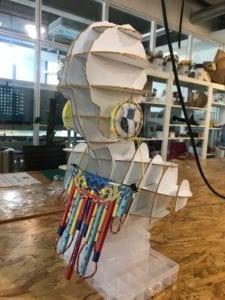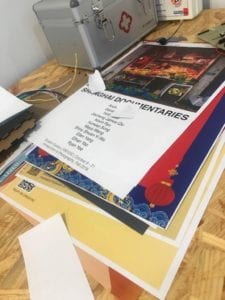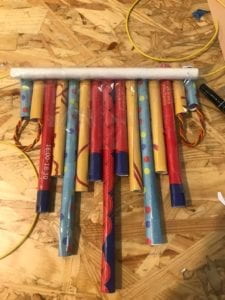Midterm Project Documentation for Jewelry Set:
Final results from my matching jewelry set in the gallery:






Project Title: “Trash Flow“
Project Statement:
The idea behind “Trash Flow” is by the ocean and for the ocean. It is an exploration of the severity of the waste presently in our oceans and the toxic materials that pollute its fauna and flora. With the symbolism of the ship’s steering wheel and the fishing nets in the earrings, I illustrate the degree of water contamination through nautical elements. However, it is important to start small, in order to make a big impact. The usage of university-held event posters from our very own NYU Shanghai hallways in the creation of the necklace, illustrates the need for involvement and awareness of the importance of proper trash disposal and limited resource waste.
Design and production/Description of creative process:
In the beginning of my brainstorming for the midterm project, I knew i wanted to create a fun and eye-catching piece that had a deeper environmental message behind it. In my search for materials for my project, I used only materials I found in the NYUSH building, mainly from the IMA labs on the 8th floor, as well as from the cafeteria and recycled trash containers all around the school.
As a main theme of my midterm, I wanted to educate the NYUSH community about the pollution in oceans and seas, as well as the daily waste that students contribute to in the academic building itself.
I collected pieces of cloth, blue thread, 2 plastic chips can lids, metal wire and cookies plastic packaging in an attempt to create a jewelry set. I also used discarded multicolor wires from the IMA lab on the 8th floor, which I twisted into one piece, as decoration for my earrings. For the necklace, I used posters from the event boards arounds school (for events that had already passed) and tape, as well as the same discarded wires and thread which I used for the earrings.








How the wearable was constructed:
All items used for the earrings and necklace were chosen from trash around campus to show that almost all plastic, paper and cloth waste can be reused or “upcycled” to create something new, without the need of creating anew product or utilizing fresh resources.
Necklace: The necklace was constructed mainly with event posters I found around the NYUSH academic building (for events that had already passed). I cut the posters in a color theme similar to that of the earrings (red, blue, yellow). The posters were cut into 2 sets of different size cutouts which I twisted around a recycled paper straw I found in the cafeteria to give each of the pieces a uniform shape. Then I pasted the paper tubes together using tape and I arranged them in a symmetrical way so that there would be equal number of tubes on each side. Then I saw that one of the posters had a beautiful dragon design on it and I decided to use this in my piece, placing it on the top to conceal the tape of the tubes.










Earrings: I used the chips can lids as the base of the earrings. Then I cut the bottom part of the cookies container and pasted it with tape to the lid. Then I placed the colorful, twisted wires on the border of the lid and attached them with tape to the plastic cookie packaging. Afterwards, I wrapped the blue woolen yarn around the earrings in a star pattern, which I once again attached with tape. Then I cut circles from the plastic bags I collected, with random patterns which I pasted on the center of the earrings to tie the whole piece together.
To create the earrings hole for attaching to the ears, I twisted a metal wire I found in room 823 and pushed it through a whole I made in the yellow chips lit. Finally, I found a rather interesting piece of cloth in the IMA lab, which was a white lace-like material with holes. It worked nicely as the final touch to the piece, which gave the jewelry a dainty feel. Lastly, I recreated the same process to create a second earring, using the same materials and process of creation.






 Research:
Research:
Links I used for my research on the effects of plastic on marine life:
https://www.nationalgeographic.com/magazine/2018/06/plastic-planet-waste-pollution-trash-crisis/
https://www.pegasusfoundation.org/the-effect-of-plastic-pollution-on-marine-life/
https://www.greenpeace.org/usa/toxic-ecosystems-the-impact-of-plastic-on-marine-life/
Images that illustrate the issue of water pollution:







Statistics of the severity of the issue:


Synopsis of my research:
- According to the United Nations, at least 800 species worldwide are affected by marine debris, and as much as 80 percent of that litter is plastic.
- Up to 13 million metric tons of plastic ends up in the ocean each year—the equivalent of a rubbish or garbage truck load’s worth every minute. Fish, seabirds, sea turtles, and marine mammals can become entangled in or ingest plastic debris, causing suffocation, starvation, and drowning.
- Half of sea turtles worldwide have ingested plastic.
- Some starve after doing so, mistakenly believing they have eaten enough because their stomachs are full. On many beaches, plastic pollution is so pervasive that it is affecting turtles’ reproduction rates by altering the temperatures of the sand where incubation occurs.
- Plastic waste can encourage the growth of pathogens in the ocean. Corals that come into contact with plastic have an 89 percent chance of contracting disease, compared with a 4 percent likelihood for corals that do not.
Significance and inspiration behind the creation:
My midterm project will include pieces of plastic and cloth waste with a central theme around the Earth’s oceans. Each of the materials for the creation of my earrings represent a main pollutant of our oceans-plastic lids, plastic packaging, cloth fragments, metal wires. I believe a project such as mine can easily be reproduced as a large-scale business and will serve as a trendy, yet socially responsible accessory since its creation requires items that would have previously been considered trash.
Necklace:The necklace represents the waste from the NYUSH student body that is produced on a daily basis and signifies the impact that each and every student can have an immense impact in the reduction of overall waste on campus. The usage of student event posters illustrates the idea that each student is responsible for the trash that they produce and must play an active role in reducing his or her waste on campus. The discarded wires from the IMA lab reflect the impact of the student labs in campus, where there is a daily usage of new wires for IMA projects, while piles of slightly used wires are thrown away.From excessive printing to the wasteful usage of IMA equipment and resources, the necklace is more than a statement fashion piece, it is a warning that trash is all around us and that it is our responsibility to be mindful of our waste contribution.

Earrings: The lacy cloth on top of the earrings is meant to allude to the discarded fishing nets that marine life often get entangled in and unfortunately result in fatalities. Lastly, the shape and symmetrical design of the earrings represent a ship’s wheel and the colors are chosen to compliment an overall nautical theme. The earrings are also composed of textile, paper and plastic waste found around campus, however they are a symbolic piece that centers around the issue with the pollution of our oceans and the frightening outlook for the future of our planet.

Collecting the necessary materials and producing my wearable:
I will be using materials i find in the IMA labs such as fabrics, plastic pieces and wire, as well as plastic bottles that I have previously purchased.








Conclusion:
The goals of my project were to educate the NYUSH student body about the waste produced on campus, as well as the immense amount of waste in our oceans. In addition to creating a rather appealing and colorful jewelry set, I believe that I satisfied the goals of my project. After engaging with my peers and showing them my creation, they stated that my message was clear and delivered in a creative and attractive way. The difficulties encountered during the creation if this project was time management and the finding of appropriate materials. However, I believe that the IMA labs, as well as multiple locations on campus provided the necessary plastic, cardboard and binding materials (thread, wire, glue, tape) to complete my vision. My desire for people viewing the jewelry set was to spark their curiosity about its meaning and educate them in an interactive way about the issue of the pollution of our oceans, which I believe was successfully accomplished. From the creative process involved in this project, I learned that people do indeed care about the pressing climate issues we are currently faced with and actively seek out ways to get involved, especially in the NYUSH community. This gave me hope that change is indeed possible and that the younger generation is not oblivious to the high degree of plastic pollution. If i were to make further changes to my project, I would expand the collection to include matching clothing and/or more accessory items, since I believe that art should make a statement and art from trash, in particular, has the very important task of not only inspiring, but also educating.
Leave a Reply